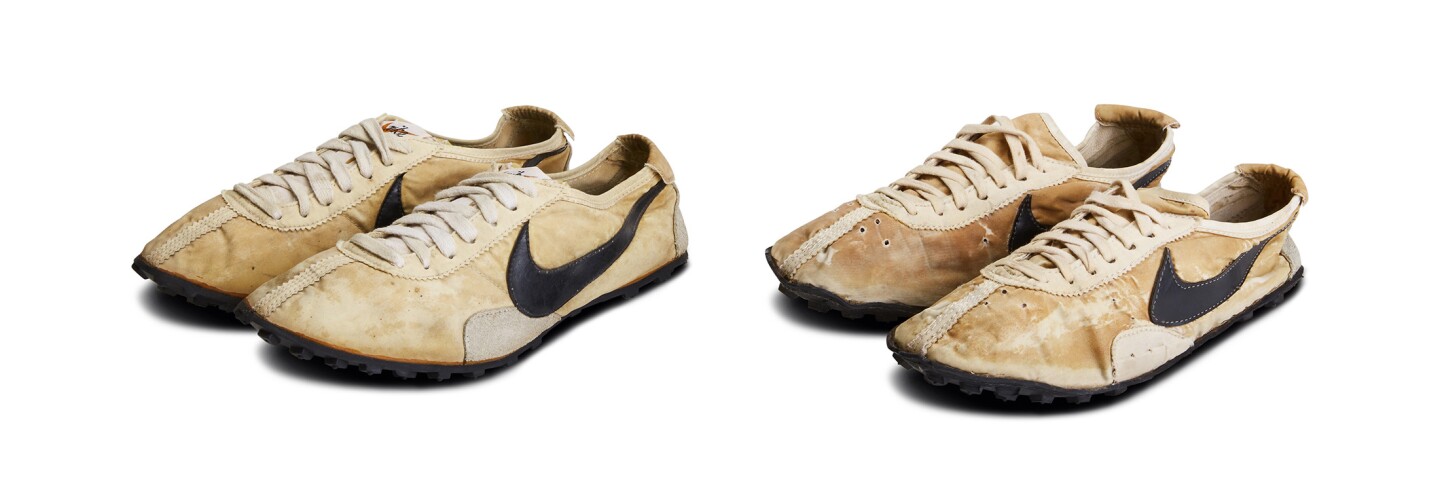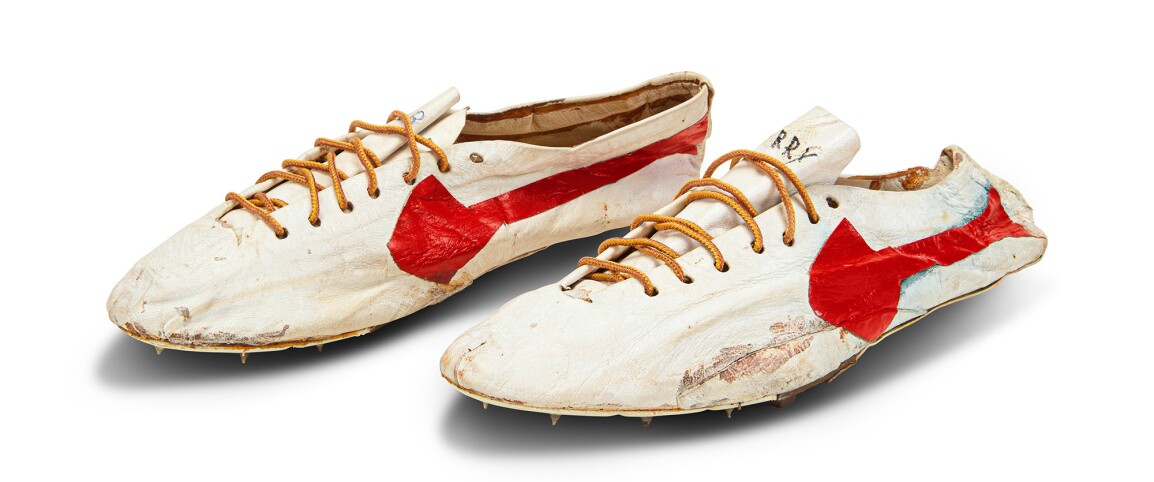S
otheby’s is proud to present, The Games, featuring a remarkable assemblage of property that spans a variety of sports from Basketball to Track & Field and Boxing. The sale is led by 5 remarkable lots including a pair of Michael Johnson worn and signed “Gold Shoes,” Michael Jordan Dual Signed Olympic Trials Worn Converse Fastbreaks, a Muhammed Ali illustration of the Fight of the Century reanimated as an NFT, multiple pairs of Nike Moon shoes which famously made their debut at the 1972 Olympic Trials, and finally, ‘Prototype Logo’ Track Spikes, created by Nike Co-Founder Bill Bowerman for Olympian Harry Jerome. Some of the property is directly related to the Olympic games, while much of it focuses on the legacy of the athletes themselves.
The Man With The Golden Shoes

In the 1996 Atlanta Summer Olympic Games Michael Johnson entered the games wearing a custom-made and never-before-seen pair of Golden Nikes. It was an incredibly bold statement, starting the race with Gold Shoes before the medal had been won, but Mr. Johnson did not disappoint, winning two gold medals for the 400 and 200 meter sprints, and setting new a Olympic record for the 400 meter and a new world record for the 200 meter. He was the first man ever to win gold medals for both of these events, and earned the nickname, “The Man With the Golden Shoes.”
The shoes themselves are a remarkable feat of engineering by Nike. Specially made only for Michael Johnson and his unique running style, the present pair featured an incredibly lightweight design. Of particular note, the shoes are asymmetrical, with mismatched soles. The spike plates were designed with the curvature of the track in mind. Nike filmed Mr. Johnson with high-speed cameras to see how his feet would interact with the track. Noticing a speed of approximately 20 Miles Per Hour around the curve, the company realized his feet acted differently from one another, and thus created spike plates to match his unique running style.
Muhammad Ali & The Fight of the Century – A Unique NFT
At 18 years old, Muhammad Ali won a gold medal in the 1960 Summer Olympic Games in Rome, Italy. Mr. Ali additionally lit the Olympic Cauldron at the opening of the 1996 Atlanta Olympic Games.
The fight between boxers Joe Frazier and Muhammad Ali was billed as “The Fight of the Century” and held on March 8, 1971 – 50 years ago. Fought in Madison Square Garden in New York City, it was widely regarded at the time as one of the biggest boxing matches in history and is still considered one of the most publicized sporting events ever. Two undefeated boxers would battle it out on the world’s biggest stage for the Heavyweight title. In this first fight (of what would become three) Frazier won in 15 rounds via unanimous decision, and it would serve as the precursor to the ‘Super Fight II’ (1974) and the ‘Thrilla in Manila’ (1975) – both of which were won by Mr. Ali.

Sotheby’s is proud to offer this unique NFT, an animation of an original never-before-seen drawing done by Muhammad Ali, which still hangs in the Ali family household. It was part of his personal portfolio of art that Mr. Ali kept private. Of particular note is Muhammad’s gentle use of color throughout the work, as well as his use of small marker points to reflect the size of the crowd. Notably, Mr. Ali depicts himself as larger than Mr. Frazier, despite his loss in the fight.
Michael Jordan 1984 Olympic Trials Worn Converse Fastbreaks
These Converse Fastbreak sneakers, manufactured in 1983 and worn by Michael Jordan in 1984, are some of the rarest Michael Jordan worn and signed sneakers in existence. One of a select grouping of examples known to exist, this pair was worn by Mr. Jordan during the 1984 Olympic Trials in the nascency of his career and before his rookie season in the NBA with the Chicago Bulls.
Best Of Michael Jordan 1984 USAB Exhibitions | The Jordan Vault
-
 Sotheby's StoriesMichael Kors Remembers His First Auction: Jackie Kennedy’s Estate | Sotheby’s Stories
Sotheby's StoriesMichael Kors Remembers His First Auction: Jackie Kennedy’s Estate | Sotheby’s Stories -
 Chinese Paintings – ClassicalWitness the Longest Bidding War: 200+ Bids for the Classical Calligraphy Scroll
Chinese Paintings – ClassicalWitness the Longest Bidding War: 200+ Bids for the Classical Calligraphy Scroll -
 The New York SalesRoy Lichtenstein’s Personal Collection: From His Studio to Sotheby's
The New York SalesRoy Lichtenstein’s Personal Collection: From His Studio to Sotheby's
Air Jordan IVs | London Olympics
Carmelo Anthony made Olympic history at the 2016 Rio De Janeiro Summer Olympic games in Brazil, when he broke LeBron James’ record and became the first Team USA Men’s Basketball player to win 4 Olympic Medals.
For the 2012 London Summer Olympics, Jordan Brand issued Anthony three pairs of Air Jordan IV Player Exclusives. All three pairs feature patriotic white and red colorways and are incredibly rare.
To The Moon
The Nike “Moon Shoe” is one of the most significant artifacts in the history of the multi-billion dollar athletic brand. With scant few known to exist, this Moon Shoe is a running shoe designed by Nike co-founder and legendary University of Oregon track coach Bill Bowerman.
As the famous story goes, Bowerman was first inspired to create the innovative waffle sole traction pattern found on the brand’s early running shoes by tinkering with his wife’s waffle iron, pouring rubber into the mold to create the first prototype of the sole. The finished design of the traction pattern created better grip and cushion than most running shoes of the time, and the waffle sole was Nike’s first major innovation as a brand. The “Moon Shoe” got its name from the resemblance between the impression that the waffle pattern left in dirt and the famous tracks left on the moon by astronauts in 1969.
These pairs originate from a student of South Eugene High School, in Eugene Oregon. Of the pairs of Moon Shoes known to exist, most were made for runners at the 1972 Olympic Trials. Notably the pair without ‘Nike’ on the tongue are considered earlier, and were likely made as testers before the 1972 Olympic Trials. The pair with ‘Nike’ on the tongue is considered later, but also date to 1972. The Trials is where Nike famously debuted the iconic design, which would ultimately launch one of America’s greatest brands.
The pairs together illustrate – in a short amount of time – the evolution of Nike’s Waffle sole, and more broadly their capabilities in innovation.
Prototype Logos
Bill Bowerman is the heart of Nike. Bowerman, one of Nike’s founders, was one of the greatest innovators of his generation in regards to shoe ingenuity and design. Obsessed with weight and performance, Bowerman would build shoes for his University of Oregon runners from scratch, often using an assemblage of raw materials. This pair, made by Nike’s Co-Founder for Harry Jerome (a Canadian Track and Field sprinter and Olympian), represents an important chapter in the origin of one of America’s greatest companies, Nike.
Most notably, the pair features the use of 4 prototype logos, which bear a remarkable resemblance to the Nike Swoosh. The shoes additionally feature, under each set of track spikes, Waffle soles – the first notable innovation introduced by Nike when they premiered the Nike Moon Shoe at the 1972 Olympic Trials.

Harry Jerome – for whom the shoes were originally made – set a total of 7 world records over the course of his career and most notably took home the Bronze Medal for Canada in the 1964 Summer Olympic Games in Tokyo, Japan – notably, the last time the Olympics took place in Japan.









